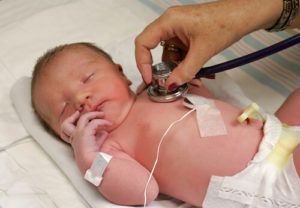Fetal Monitoring Errors

Fetal distress occurs when a baby’s oxygen supply is compromised (medically referred to as hypoxia), whether in utero or during the birthing process. A variety of factors lead to fetal distress, which can occur early on in one’s pregnancy or during labor and delivery.
Medical professionals rely upon something called a fetal monitor in order to detect the signs and symptoms of fetal distress, which allows them to act immediately to avoid unnecessary harm to an unborn child. If medical intervention is not sought immediately, or if a doctor fails to identify a situation in which an unborn child is experiencing fetal distress, the consequences can be deadly. Please call Stern Law, PLLC at (800) 462-5772 for a free consultation to discuss your case.
How does fetal monitoring work?
During labor, medical professionals are supposed to rely upon your child’s heart rate to monitor how well he or she is tolerating your contractions. There are two types of fetal monitoring methods – internal and external. Internal monitoring involves attaching an electrode to a baby’s scalp once a mother’s cervix is dilated between two to three centimeters and the child’s head is engaged in the birth canal. External monitoring involves the use of a belt that is strapped around a mother’s abdomen, which records her contractions as well as the child’s heart rate.
In both internal and external monitoring, data is transferred through wires that are connected to a special type of machine that regularly records and prints out information in the form of two graphs. Specifically, the top graphs show the fetal heart rate measured in beats per minute and the bottom graph charts the mother’s contractions.
[videosingle id=”29108″ width=”95%” height=”400″ /]
What Is Electronic Fetal Monitoring? from The CP Lawyer | Stern Law, PLLC on Vimeo.
Before delivery, your baby’s heart rate can either be checked intermittently or continuously, depending upon the circumstances. If your child appears to be doing well, a doctor may only monitor the child’s well-being every hour, or intermittently. If your child’s heart rate demonstrates the early warning signs of distress, or if you are diagnosed as having a high-risk pregnancy, a doctor will likely monitor the child on a more regular and perhaps even a continuous basis.
Reassuring vs. non-assuring fetal heart patterns
A normal fetal heart rate ranges between around 110 to 160 beats per minute. During fetal monitoring, fluctuations in a fetal heart rate are referred to as “variability.” A certain level of variability in fetal heart rhythms is normal and typically occurs in short-lived accelerations and decelerations.
To illustrate, when a woman has a contraction, a child’s heart rate may drop slightly but then return to normal once the contraction has ended. Under these circumstances, a baby’s heart rate is considered to be “reassuring,” which demonstrates that the child is well-oxygenated and is able to withstand the labor and delivery process.
Non-assuring fetal heart patterns occur when a child is experiencing a heart rate greater than 160 beats per minute (tachycardia) or lower than 110 to 120 beats per minute (bradycardia) for extended periods of time. These types of long lasting decelerations and accelerations often signal that a child is experiencing distress, requiring a doctor to implement immediate measures to avoid harm to the child.
What can happen as a result of improper fetal monitoring?
Medical practitioners and nurses should carefully monitor a baby during the labor and delivery process in order to determine how a child is tolerating his or her mother’s contractions. When a child is improperly monitored, it can cause serious and sometimes life threatening injuries to both you and your baby, such as:
- Cerebral palsy;
- Stillbirth;
- Brain damage;
- Paralysis;
- Placental abruption;
- Hypoxia/apoxia;
- Developmental delays.
What are the types of fetal monitoring errors?
When a child is born with birth injuries, there is a chance that they could have been caused by fetal monitoring errors committed by negligent doctors and hospital staff. Examples of fetal monitoring errors are as follows:
- Failure of medical professionals to properly identify abnormal fetal heart rhythms;
- Failure to ascertain whether a woman requires more regular or continuous fetal monitoring;
- Failure of a fetal monitoring device to work properly;
- Failure of healthcare professionals to take immediate medical action when the signs of fetal distress are present;
- Failure to correctly read a fetal monitor to distinguish between maternal and fetal heart rates;
- Failure to correctly use a fetal monitor;
- Lack of clinician training and/or experience in reading fetal heart patterns and using a fetal heart monitor.
If your baby suffered distress during delivery and improper fetal monitoring led to avoidable injury, you might be entitled to significant compensation. Please contact Stern Law, PLLC to share the details of your case: Call (800) 462-5772 for free today.







